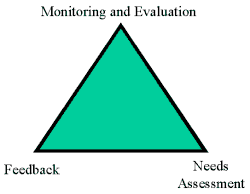Continual Improvement
| The Seven Triads of Sustainability: | |||||||
| 6 | |||||||

The key operational components of continual improvement is a monitoring and evaluation put in place that checks the progress of a programme or project. An efficient needs assessment system also enables setting up targets and goals against which progress can be measured and monitored. Feedback from community members help in increasing efficiency and effectiveness.
Continual Improvement also includes such issues as capacity building, indicators etc.
The system of team work to build houses has proved itself efficient in the fight against the housing deficit, specially the experience (unedited and pioneer) that was accomplished by the CMB (Brazilian Women's Conference) that guarantees to the mothers head of families the access to their own houses.
Coming from slum tenement houses, "favelas" (group of very poor and small houses) the women were called to join the team work to build their houses. Today they live in a "conjunto habitacional" (a group of houses built in order to form a community) which also have water and sewage system, paved streets, schools, health units and day nurseries among other improvements.
Both solidarity and union, which are developed during the building of the houses, are essential factors to achieve the aims and objectives of each stage. The constant improvement of the environment where they live, providing them with the necessary social equipment and substructure, is a result of the women's action. The solidarity comes up in the help of the affiliated women who do not take part in the team work and who help the others by looking after their children. Besides getting their own house, improving their standard of living, the women find out their potential and their capacity. Many of them conclude the work by becoming skilled carpenters, electricians, joiners, etc., also learning to read and write, and are trained to work as health community agents.
Development and use of indicators play key roles in getting communities be aware of impacts of environmental programmes and projects, by clarifying the goals, determining who will lead the process, inviting participation, deciding how to choose indicators, collecting data by which to measure the indicators, reporting on the indicators, and updating and revising the indicators.
In Seattle, USA, hundreds of citizens have been involved in designing and researching the indicators to assess the state of the environment in local communities. The Sustainable Seattle Project was initiated in 1992, when a civic panel of 150 citizens convened by the Sustainable Seattle - a volunteer association of citizens working to ensure a healthy and vital future for the Seattle region, participated in the forum in order to propose and select indicators. As a result of the meeting, 99 indicators were proposed, of which 40 key indicators were selected based on the data gathered from a variety of sources including public information, synthesis of existing research, and public opinion polling. Indicators cover items such as water consumption, per capita waste generation, recycling rates, household incomes, and volunteering in schools.
The development and regular assessments of indicators have enabled citizens to foster community dialogue about their future, track progress toward the goals of sustainable living and development, and facilitate local actions in order for individuals and groups move indicators in a positive direction over time.
In order promote local actions, the project encourage citizens in Seattle area to employ local media to spread indicator results and analysis, use the political process to promote change in public policy, broaden the information base used for economic decision making, use indicators in schools for education and as a basis for additional research, form a basis for linking local nonprofit and volunteer groups, and question personal lifestyle choices.
| The Seven Triads of Sustainability: | |||||||
| 6 | |||||||
 |
Return to the cover page Contact: Hari Srinivas - hsrinivas@gdrc.org |